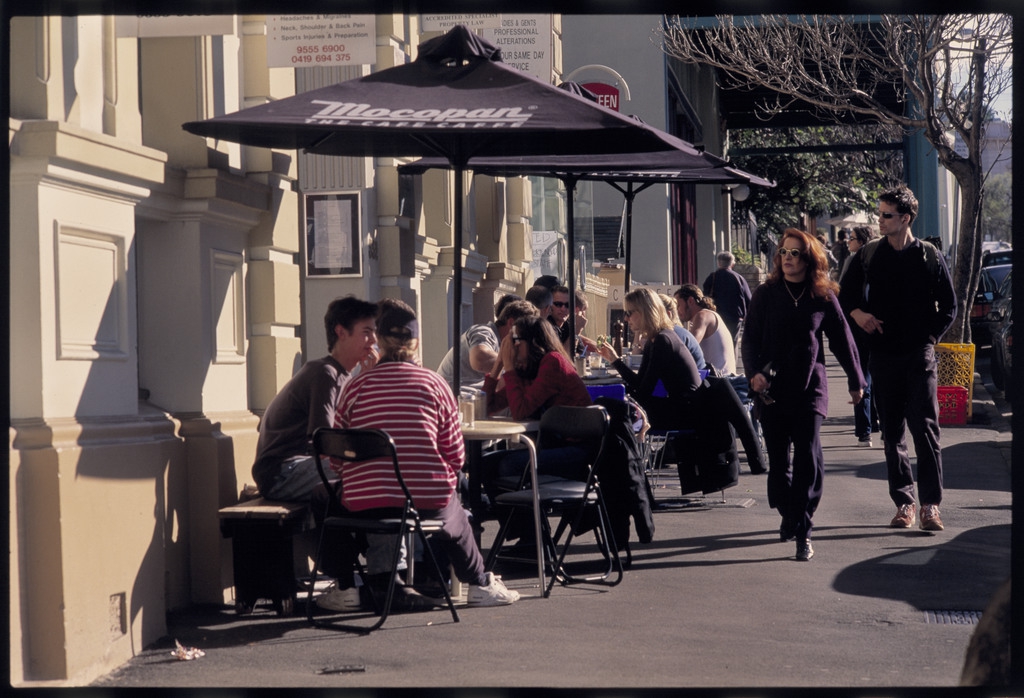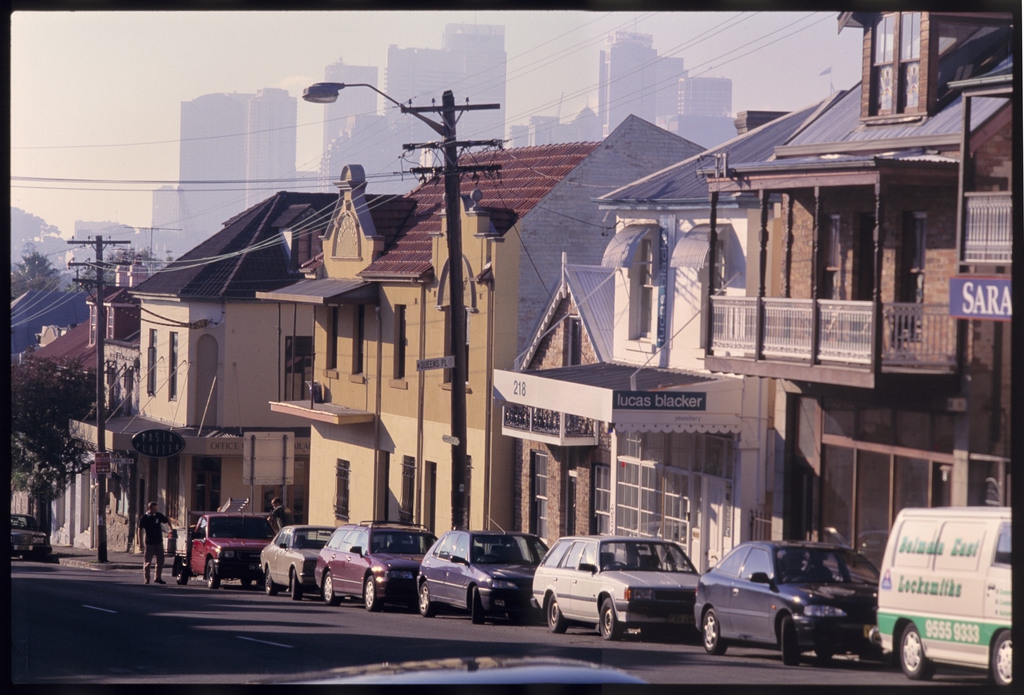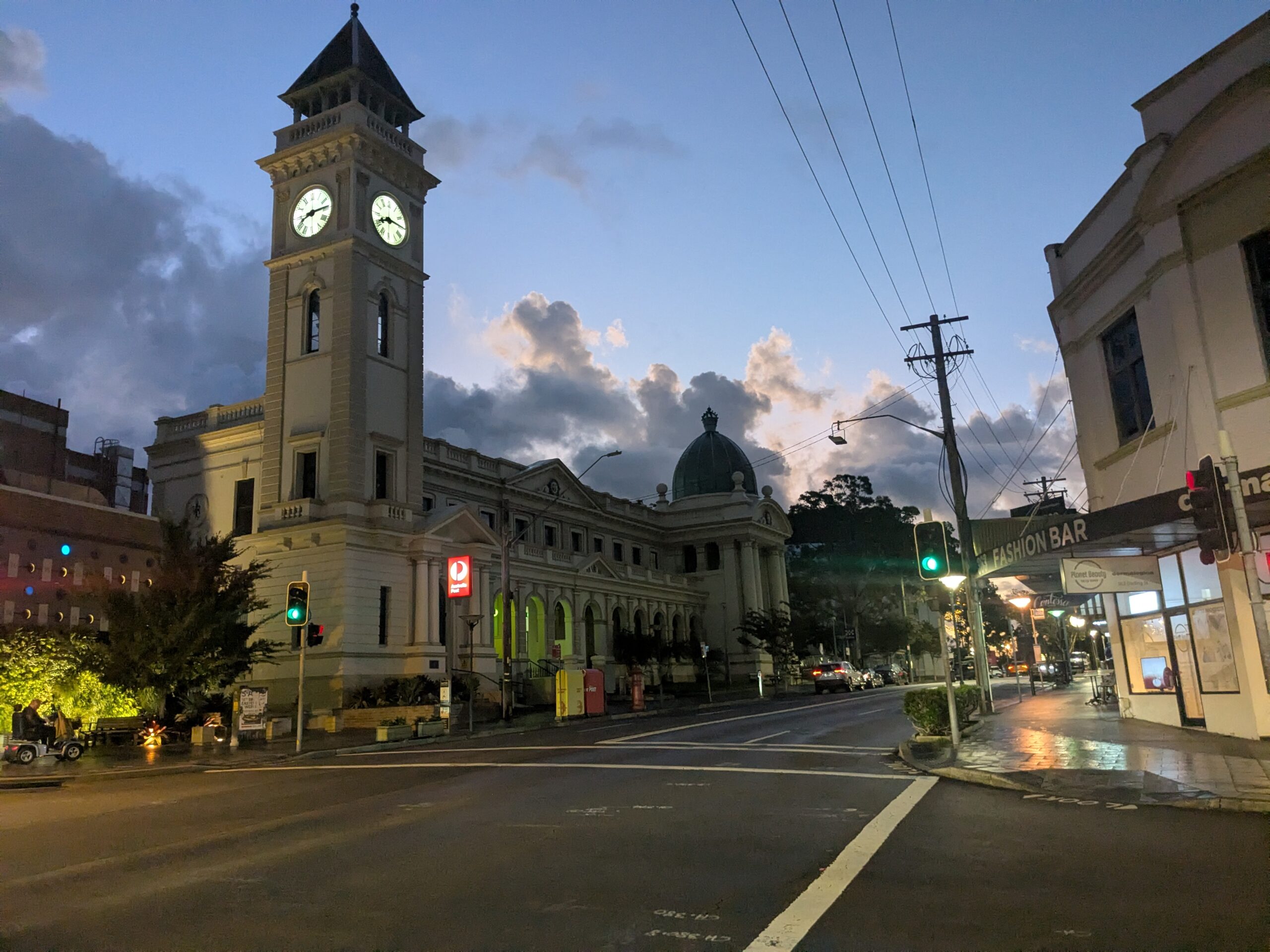
Darling Street in 1999, outside the Institute Arcade, by Philip Gostelow, from the State Library of NSW
Balmain has been our home in Sydney since we arrived here shortly before Christmas in 2021. Physically, our life has revolved around Darling Street. It is a nice feeling to be locally anchored for a peripatetic family like ourselves.
We moved a stone’s throw away from Darling Street on the Rozelle end when we came, and with a year and half interruption are now back less than a hundred meters from Balmain’s main thoroughfare.
The street snarls across the peninsula atop a ridge for about three kilometers, side streets dropping down towards the harbour on both sides. You get a good view of the CBD’s skyline from several points.
Only towards the end, in Balmain East, does Darling Street drop steeply, and culminates in the cul-de-sac by the ferry wharf, where you can continue the journey by boat to the city, with Barangaroo’s towers less than a kilometer away across the water.
We do most of our local shopping on Darling Street, in the supermarket, pharmacy, bookshop, bakery, drugstore, bottle shops. I get my hair cut in one of the cheap barber shops. We grab a coffee in one of the myriad cafes, or a drink in one of the various pubs–although the better ones are actually off Darling Street, at least in my opinion.
The street is also home to the post office and the library, close to where we live, and both of which we use a lot. Further down is our family doctor, our older daughter’s arts and crafts center is just a few meters off Darling Street at its Rozelle end. My physio is right opposite, on Victoria Road. The list goes on.

Another photo by Philip Gostelow taken in 1999 from the NSW State Library, depicting Darling Street near Queen’s Place (same link as above)
In this car dependent society, this pedestrian friendly street feels like an oasis of walkability and neighborhood cohesion. I get nods from familiar faces. People in shops remember my name.
But this idyllic suburban cliché we live here is not perfect. Darling Street is dead after 8pm. There is high turnover and many empty shopfronts. Residential rental prices in the area have skyrocketed in tandem with house prices, and landlords want a slice of the cake and price out the local specialty shop.
Along with structural shifts in the economy and demographic change in the area, this doesn’t bode well for small independent retailers. Indeed, many have closed shop since we moved here and especially recently has there been an uptick in closures. This is a familiar phenomenon across other gentrifying areas.
A lot of restaurants complain that the number of out-of-Balmainers coming for dinner has declined. Parking is scarce and pricey. Maybe reflecting the limited market, very few of Balmain’s restaurants are good, hardly any very good.
The area’s reputation as a culinary hotspot seems to have declined. Young families are done with dinner by 6:30 pm, and an increasingly old public is not leaving it till much later.
In that sense, Balmain’s real estate fetish gnaws at its own foundations: Agents generically use Darling Street as a major selling point when peddling their properties. But the affluent people moving in (or those crushed by high mortgage payments) have different shopping habits. Young people can hardly afford to live in the neighborhood. Eventually, the high street becomes a shadow of its former self.

Darling Street at night, with the Post Office and former Town Hall as well as the library in the back
Will turning Darling Street into a special entertainment district help? The Inner West Council has floated this plan and will let venues face fewer restrictions and longer opening hours. There are a few pubs and bars on the designated stretch that would benefit from this.
However, the success of a revamped night-time Darling Street rests on out-of-Balmainers coming for a night out given how few local people are out and about on a regular night. There are other initiatives like a revamped biweekly market that aim to revitalize the area.
Further afield, the White Bay Power Station’s conversion into an art and cultural space is very promising. In a few years there might also be hundreds if not thousands of new residents living in proximity to a new metro station close to the power station.
These developments are unlikely to bring in lots of affordable housing. And whether or not they will be able to make Balmain “less boring” remains to be seen. (The rezoning vs. NIMBY debate should be the topic of another post on this blog in the future.)
Two articles from the Sydney Morning Herald caught my attention last year, when I had this post on my mind already, and sum up the debate with a bit more local colour.
The first one argues that Balmain is boring, not equitable, and that people won’t come here for nightlife. In only ten years (2011-2021) the median age has increased by 4 years from 38 to 42. The author calls for more radical change, even touting a tunnel under Johnston’s Bay to Barangaroo. That might not be going down well with the local population–call it NIMBYism or whatever.
A riposte to the article came a day later. “If you think Balmain is boring, you are not doing it right”, with the text mainly referring to the area’s many pubs. Indeed, Balmain has the highest density of pubs in Australia (surely landing it a high ranking globally given relatively liberal alcohol consumption patterns here).
The article goes on to say that the real reason that not many people from outside the area come is related to the psychological barrier that is Anzac Bridge, according to the author, a well-known local radio host and resident of Balmain. (In this interpretation the slow death of Balmain’s nightlife should have begun in the mid-1990s, when the bridge was built.) The fact that real estate is so pricy is obvious given the area’s proximity to the CBD, as evidence from any global city can confirm.
What, then, is the unique selling point of Balmain? Is it its rich industrial history, explaining the large number of pubs? Are these pubs special enough for people to come from afar, ditching their own local in search of some authenticity, grit, history?
While these pubs were once the watering holes for the thousands of factory, wharf and other blue-collar workers living in the area, they cater to a different audience today, one that is decidedly not working class. The more successful pubs are those going with the times, serving oysters instead of traditional pub grub.
Heritage is often commodified and “extracted” like so many other things for individual profit. It is a shallow discourse and does not get beyond a few lines of text, like “Balmain was once an industrial center” sprinkled with a little factoid and a black and white photo perhaps.
That is not to suggest that there is no heritage discourse, quite the contrary. The Balmain Association is an active local organization based out of the Balmain Watch House, and driven by local initiative. It has produced ample, deeply researched original material since its founding in 1965. The Balmain Library also has a collection of local history works, and often hosts local events.
Yet my contention is that the forces of real estate economics are parasitic to heritage considerations and eventually lead to a hollowing out of the debate. People regard heritage as a value-add to their housing assets. Period features, original facades, inscriptions, etc. are viewed from this angle. There is little regard for the area’s post-European settlement social and cultural history.
Of which there is an abundance here: Australia’s labour movement originated in Balmain, no wonder given the masses of workers housed in substandard terraces, physically close to the factory owners. There were famous strikes, for example in the shipyards in Mort Bay. Alcohol soothed the grim reality for many workers, and pubs provided space to organize, to dream of a different, more just society. Trams rambled up and down Darling Street, bringing workers to and from their workplaces.
Today, the street is falling victim to the area’s relentless transformation in a post-industrial, real estate obsessed city, sharing the fate of many gentrified areas in Sydney, Australia and the world.
